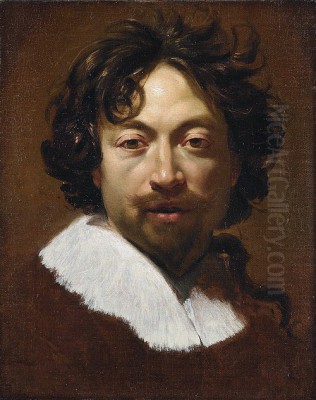
Simon Vouet (1590-1649) stands as a monumental figure in the annals of French art history, celebrated primarily for his instrumental role in introducing the Italian Baroque style to France. Born in Paris, his career bridged the vibrant artistic worlds of Italy and his homeland, leaving an indelible mark on the trajectory of seventeenth-century French painting. His life was one of artistic pilgrimage, royal patronage, and profound influence, shaping not only the aesthetic sensibilities of his time but also nurturing a generation of artists who would further define French classicism and Baroque grandeur.
Early Life and Artistic Genesis
Simon Vouet was born into an artistic milieu in Paris in 1590. His father, Laurent Vouet, was a painter of modest renown, providing young Simon with his initial artistic instruction. This early exposure to the craft within his own family undoubtedly laid the foundation for his prodigious talent, which manifested at a remarkably young age. Accounts suggest that by the age of fourteen, Vouet was already accomplished enough to travel to England to paint portraits. His precocity was further evidenced by a journey to Constantinople (modern-day Istanbul) around 1611, where he was commissioned to paint the portrait of the Sultan, an impressive feat for a young artist, though the work itself has not survived. This early period of travel and diverse commissions honed his skills and broadened his artistic horizons, preparing him for the transformative experiences that lay ahead in Italy.
Following his time in Constantinople, Vouet made his way to Venice in 1612. The Venetian school, with its emphasis on rich color, dynamic compositions, and the sensuous depiction of light, as exemplified by masters like Titian, Tintoretto, and Paolo Veronese, would have offered a dazzling array of influences. Though his stay in Venice was relatively brief, the city's artistic heritage likely left a lasting impression, particularly its mastery of color and atmospheric effects, which would subtly inform his later work.
The Italian Sojourn: A Crucible of Style
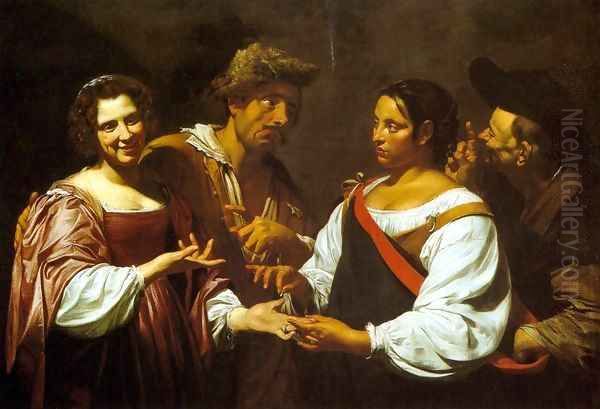
In 1613 or 1614, Simon Vouet arrived in Rome, the undisputed artistic capital of Europe. This marked the beginning of a nearly fifteen-year period that would be crucial to his artistic development and establish his reputation. Rome at this time was a melting pot of artistic innovation and tradition. The revolutionary naturalism and dramatic chiaroscuro of Michelangelo Merisi da Caravaggio, who had died only a few years prior (1610), still cast a long shadow. Vouet was profoundly affected by Caravaggio's style, adopting the strong contrasts of light and dark, the direct observation of models, and the theatrical intensity that characterized Tenebrism.
During his initial years in Rome, Vouet became one of the most distinguished followers of Caravaggio, producing works that demonstrated a powerful command of this new, dramatic idiom. His paintings from this period often feature robust figures, stark lighting, and a palpable sense of realism. He associated with other artists drawn to Caravaggio's orbit, including figures like Bartolomeo Manfredi, Orazio Gentileschi, and his daughter Artemisia Gentileschi, who were all exploring different facets of the Caravaggesque style.
However, Vouet was not merely an imitator. His artistic intelligence allowed him to absorb and synthesize various influences. Beyond Caravaggio, he studied the works of the High Renaissance masters, particularly Raphael, and was also receptive to the classicizing trends emerging from the Bolognese school, led by Annibale Carracci and his followers, such as Domenichino and Guido Reni. Reni's elegant figures, refined compositions, and lighter palette offered an alternative to the starkness of Caravaggism, and Vouet gradually began to incorporate these elements into his work. He also looked to other Italian Baroque masters like Guercino, whose dynamic compositions and rich colorism were influential.
Vouet's talent and adaptability did not go unnoticed. He received prestigious commissions from influential patrons, including the Barberini family, whose most prominent member, Maffeo Barberini, ascended to the papacy as Pope Urban VIII in 1623. This patronage significantly elevated Vouet's status. He painted altarpieces and easel paintings for churches and private collectors, demonstrating a versatility that encompassed religious narratives, mythological scenes, and portraiture. His success was such that in 1624, he was elected president (Principe) of the Accademia di San Luca, Rome's prestigious academy of artists, a testament to the high esteem in which he was held by his peers. During his Italian period, he also married Virginia da Vezzo (also known as Virginia di Vetsi or Virginia Vouet), an accomplished painter in her own right, who often modeled for him and assisted in his studio.
Return to France: Premier Peintre du Roi
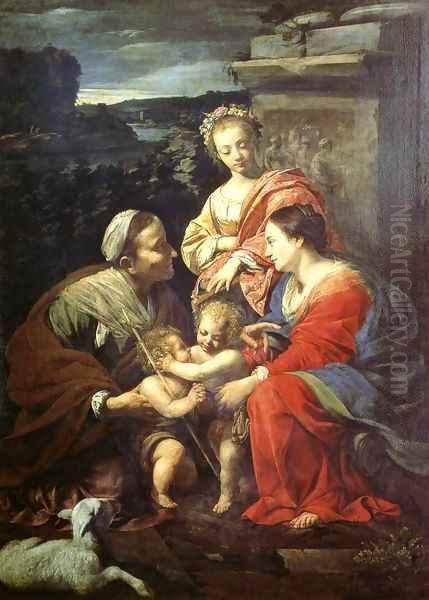
In 1627, after nearly fifteen years in Italy, Simon Vouet was summoned back to France by King Louis XIII and his chief minister, Cardinal Richelieu. He was appointed Premier Peintre du Roi (First Painter to the King), a prestigious position that came with significant responsibilities and opportunities. His return marked a turning point for French art. At this time, French painting was still largely dominated by the late Mannerist style, which appeared somewhat provincial compared to the dynamic developments in Italy. Vouet, armed with his extensive Italian experience and a sophisticated, modern style, was poised to revitalize the artistic scene in Paris.
Upon his return, Vouet established a large and highly productive workshop. He was tasked with a wide array of projects, including altarpieces for Parisian churches, mythological and allegorical paintings for royal and aristocratic residences, and designs for tapestries. He undertook major decorative schemes for the Palais du Louvre, the Palais du Luxembourg (for Marie de' Medici), and numerous châteaux and hôtels particuliers (private mansions) of the nobility, such as the Hôtel Séguier and the Château de Chilly.
His style in France evolved from the more pronounced Caravaggism of his early Roman years. While retaining a sense of drama and plasticity, his palette became brighter and more varied, his compositions more elegant and graceful, and his figures often idealized, imbued with a lyrical charm. This adaptation reflected the tastes of the French court, which favored a more decorative and less austere form of Baroque than the intense naturalism of Caravaggio. Vouet successfully fused Italian grandeur with a distinctly French sensibility, characterized by clarity, elegance, and a certain decorative refinement. This new style, often referred to as French Baroque, was immensely influential.
Vouet's Artistic Style: Evolution and Characteristics
Simon Vouet's artistic style underwent a significant evolution throughout his career, reflecting his journey from a Caravaggesque painter in Rome to the leading exponent of a more classical and decorative Baroque in Paris.
In his early Italian phase, Vouet's work was characterized by strong tenebrism, with dramatic lighting creating sharp contrasts between illuminated figures and dark backgrounds. Works from this period, such as The Fortune Teller (c. 1620, National Gallery of Canada) or David with the Head of Goliath (c. 1620-1622, Palazzo Bianco, Genoa), exhibit a robust naturalism and psychological intensity typical of Caravaggio's followers. Figures are often depicted with a raw, unidealized quality.
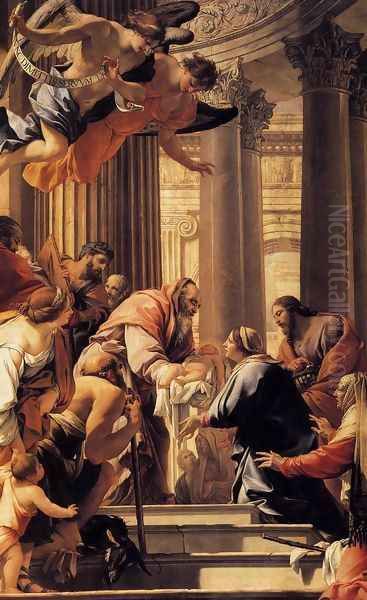
As he matured in Rome, and particularly under the influence of Bolognese painters like Guido Reni and Domenichino, as well as Venetian colorists, Vouet's style began to soften. His palette lightened, his compositions became more balanced and harmonious, and his figures acquired a greater elegance and idealization. Works like The Holy Family with St. John the Baptist (c. 1626, Prado Museum) show this transition, with a more refined handling of form and a gentler interplay of light and shadow.
Upon his return to France, Vouet's style crystallized into what is now recognized as his signature French Baroque manner. This style was characterized by:
Luminous Color: He employed a rich and varied palette, often featuring vibrant blues, reds, and golds, applied with a fluid brushwork.
Elegant Figures: His figures, whether in religious, mythological, or allegorical scenes, were typically graceful, with idealized features and expressive gestures. He excelled in depicting sensuous female nudes and cherubic putti.
Dynamic Compositions: While often complex and filled with figures, his compositions remained clear and well-organized, frequently employing diagonal lines and swirling movement to create a sense of dynamism.
Decorative Quality: Many of his works, especially large-scale decorative schemes, possessed a strong decorative appeal, well-suited to the opulent interiors of palaces and churches. He skillfully integrated figures with architectural and landscape elements.
Versatility in Subject Matter: Vouet tackled a wide range of subjects, including grand religious altarpieces, elaborate mythological and allegorical cycles, and insightful portraits. His religious works often conveyed a sense of piety and devotion, while his mythological scenes celebrated sensuality and classical learning.
His approach was less intellectually rigorous than that of his contemporary Nicolas Poussin, who championed a more austere and archaeologically informed classicism. Vouet's art was more accessible, appealing to the senses with its rich colors, graceful forms, and dramatic flair. It was this more decorative and approachable Baroque that initially found greater favor at the French court.
Key Masterpieces
Simon Vouet's extensive oeuvre includes numerous masterpieces that highlight his skill and stylistic evolution.
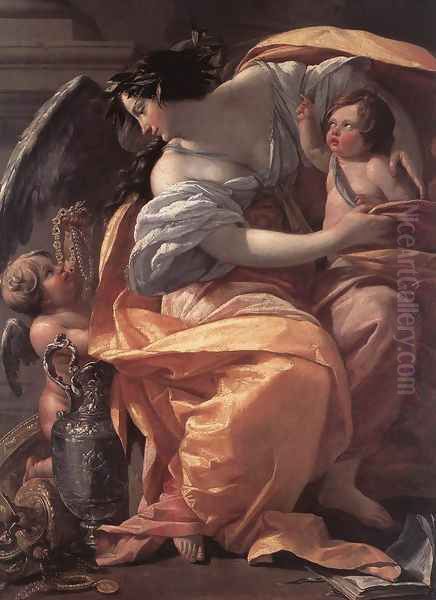
One of his most celebrated works is The Presentation in the Temple (c. 1640-1641), painted for the high altar of the Jesuit church of Saint-Louis (now Saint-Paul-Saint-Louis) in Paris, commissioned by Cardinal Richelieu. This monumental altarpiece exemplifies his mature French style. The composition is grand and theatrical, with figures arranged in a dynamic yet balanced manner. The Virgin Mary gently presents the Christ Child to Simeon, the High Priest, in a scene filled with solemnity and tenderness. The colors are rich and harmonious, and the lighting, while still creating a sense of volume, is softer and more diffused than in his Caravaggesque period. The figures are noble and idealized, their gestures expressive and graceful. The work masterfully combines religious devotion with Baroque splendor.
Other notable works include:
Lot and His Daughters (c. 1633, Musée des Beaux-Arts de Strasbourg): A powerful and dramatic depiction of the biblical story, showcasing his ability to convey intense emotion and his mastery of the human form. The lighting still retains a Caravaggesque intensity, but the figures possess a classical poise.
Allegory of Wealth (c. 1630-1635, Musée du Louvre, Paris): This painting, with its opulent depiction of a female figure surrounded by symbols of abundance, is a fine example of his allegorical work, characterized by rich textures and a sensuous appeal.
Time Vanquished by Hope, Love, and Beauty (c. 1627, Prado Museum, Madrid): Painted shortly after his return to France, this allegorical work shows Father Time being overcome by youthful figures. It is notable for its dynamic composition, vibrant colors, and the graceful rendering of the figures.
The Virgin and Child with an Angel (or Madonna Hesselin, c. 1630-1635, Musée du Louvre, Paris): A tender and intimate depiction, showcasing Vouet's ability to convey warmth and humanity within a religious context. The soft modeling and sweet expressions are characteristic of his French period.
Portrait of Angélique Vouet (c. 1635-1638): A charming portrait of his daughter, demonstrating his skill in capturing individual likeness and personality.
The Vision of Saint Catherine of Alexandria (early Italian period): This work would exemplify his engagement with Caravaggesque drama and lighting during his formative years in Rome.
His large-scale decorative cycles, such as those for the Château de Wideville or the Galerie de l'Hôtel de Bullion (largely dispersed or destroyed but known through engravings and preparatory drawings), were also highly significant, transforming the interiors of aristocratic residences with their mythological and allegorical narratives.
The Workshop and Vouet's Legacy as a Teacher
Simon Vouet's impact on French art was amplified by his role as a teacher and the head of a large, influential workshop. Upon his return to Paris, his studio became the principal training ground for a new generation of French painters. He effectively established a "school" that disseminated his style and techniques.
Among his most prominent pupils were:
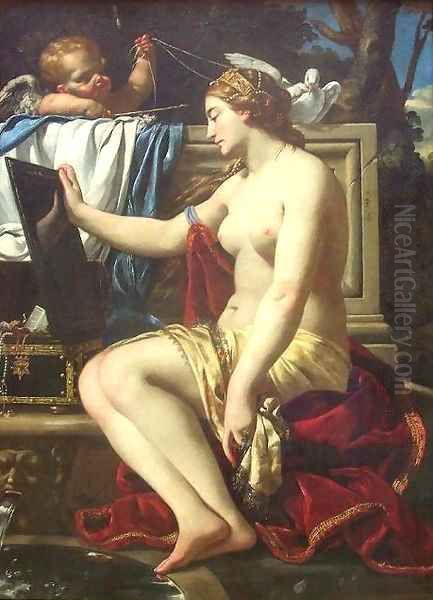
Charles Le Brun (1619-1690): Perhaps Vouet's most famous student, Le Brun would go on to become the dominant figure in French art during the reign of Louis XIV, orchestrating the artistic projects at Versailles and heading the Royal Academy of Painting and Sculpture. Le Brun absorbed Vouet's grand manner and organizational skills, later developing his own powerful, classicizing Baroque style.
Eustache Le Sueur (1616-1655): Another significant pupil, Le Sueur developed a more gentle and lyrical style, often characterized by its delicate color harmonies and quiet piety. He is sometimes referred to as the "French Raphael."
Pierre Mignard (1612-1695): Known as "Mignard le Romain" due to his long stay in Rome, he became a rival to Le Brun after Vouet's death, particularly renowned for his elegant portraits and decorative paintings.
Michel Dorigny (1616-1665): Vouet's son-in-law (he married Vouet's daughter Françoise), Dorigny was a close collaborator and an accomplished painter and engraver in his own right, helping to popularize Vouet's compositions through prints.
Nicolas Chaperon (1612-1656): A painter and engraver who worked in Vouet's circle before establishing his own career, primarily in Rome.
Charles Poerson (1609-1667): Another student who became a successful painter, eventually becoming director of the French Academy in Rome.
Louis Testelin (1615-1655): A painter and founding member of the Académie Royale.
Vouet's workshop was highly organized, enabling him to undertake numerous large-scale commissions. He would typically provide initial designs and sketches, with assistants and pupils carrying out much of the execution under his supervision, Vouet himself often adding the finishing touches. This collaborative method was common in Baroque studios. He also collaborated with his brother, Aubin Vouet (1595-1641), who was also a painter.
Through his teaching and the prolific output of his studio, Vouet effectively shaped the course of French painting for several decades. He introduced a modern, Italianate style that was grand, decorative, and versatile, providing a foundation upon which later artists like Le Brun would build the academic tradition of French classicism. He also played a role in the early discussions that led to the founding of the Académie Royale de Peinture et de Sculpture in 1648, an institution that would dominate French art for centuries.
Contemporaries, Collaborators, and Rivals
Simon Vouet operated within a dynamic artistic landscape, interacting with numerous other artists. In Italy, aside from the Caravaggisti and Bolognese masters, he would have been aware of other leading figures like Pietro da Cortona and Gian Lorenzo Bernini, who were also shaping the Roman Baroque.
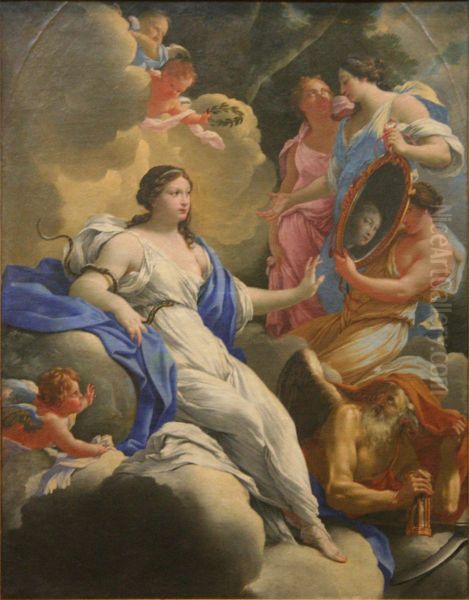
Upon his return to France, he became the leading painter, but he was not without contemporaries or eventual rivals. Nicolas Poussin (1594-1665), though spending most of his career in Rome, was a towering figure whose intellectually rigorous and archaeologically informed classicism offered a distinct alternative to Vouet's more decorative Baroque. While Poussin was briefly in Paris (1640-1642) and worked for the King, his austere style did not initially find as much favor at court as Vouet's, though Poussin's influence would grow immensely in the latter half of the century and beyond. There was a degree of professional rivalry between Vouet and Poussin, representing two different currents within French art.
Other notable French painters of the period included Philippe de Champaigne (1602-1674), a Flemish-born artist whose style was more austere and deeply influenced by Jansenist piety, excelling in portraiture and religious works. Georges de La Tour (1593-1652), working in Lorraine, developed a unique Caravaggesque style characterized by quiet introspection and masterful candlelit scenes, though he was more isolated from the Parisian mainstream. Laurent de La Hyre (1606-1656) was another Parisian contemporary who developed an elegant, classicizing style, sometimes referred to as "Parisian Atticism."
Vouet's collaborations extended to his family. His wife, Virginia da Vezzo, was a painter, and his brother Aubin Vouet also worked as an artist, sometimes in a style close to Simon's. His son-in-law, Michel Dorigny, was a key collaborator, particularly in disseminating his compositions through engravings.
Anecdotes and Personal Glimpses
While detailed personal anecdotes about Vouet are somewhat scarce compared to some other artists, certain aspects of his life offer glimpses into his character and career. His early travels to England and Constantinople at such a young age suggest a confident and adventurous spirit, as well as a precocious talent that was recognized early on. The commission to paint the Sultan is a particularly intriguing episode, highlighting his early international reputation.
His election as Principe of the Accademia di San Luca in Rome underscores his leadership qualities and the respect he commanded among his peers in the highly competitive Roman art world. His marriage to Virginia da Vezzo, an artist herself, suggests a partnership that extended into their professional lives.
The summons back to France by Louis XIII and Richelieu was a clear indication of his established fame. However, his dominance in Paris was not without challenges. The rivalry with Poussin, though perhaps more stylistic than personal in its overt manifestations, represented a significant artistic debate of the time. There are also mentions of an unrealized project to establish a grand art center or academy in Paris, which, had it come to fruition under his direction, might have further solidified his institutional influence.
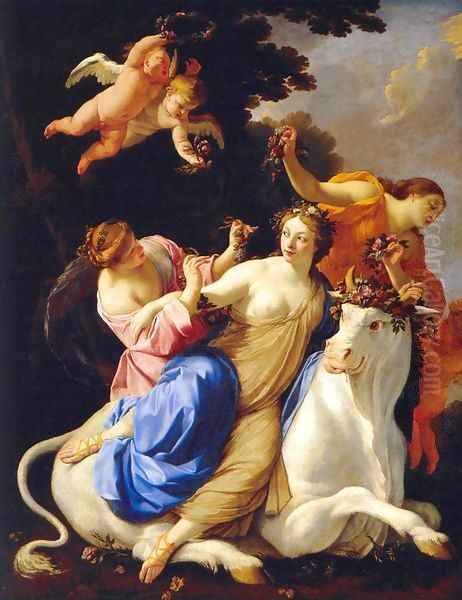
His prolific output and the sheer scale of many of his decorative projects point to a highly organized and industrious individual, capable of managing a large workshop and meeting the demands of powerful patrons. The portraits of his family members, like that of his daughter Angélique, offer a more personal dimension, revealing a tender and affectionate side.
Historical Reception and Modern Scholarship
In his lifetime and for a period thereafter, Simon Vouet was immensely celebrated. He was the dominant force in Parisian painting from his return in 1627 until his death in 1649. His style set the standard, and his workshop trained the next generation of leading artists. Early art historians and critics like André Félibien, who was a contemporary, acknowledged his importance in introducing a more modern, Italianate manner to France.
However, with the rise of a more austere classicism championed by Poussin and later codified by the Royal Academy under Charles Le Brun, Vouet's reputation began to wane somewhat in the later 17th and 18th centuries. His style was sometimes perceived as overly decorative or less intellectually profound than Poussin's. The emphasis shifted towards the more severe and morally edifying qualities of Poussinist classicism.
The 19th century saw a general neglect of many Baroque artists, including Vouet, as tastes shifted towards Romanticism, Realism, and later, Impressionism. It was not until the 20th century, with a broader reassessment of Baroque art, that Vouet's significance began to be fully appreciated again. Scholars started to re-evaluate his contribution, recognizing him not just as an importer of Italian styles but as a creative force who forged a distinctly French Baroque idiom.
Modern scholarship has continued to explore various facets of Vouet's career. Numerous exhibitions, including a major retrospective at the Grand Palais in Paris in 1990-1991 and more recent focused exhibitions, have brought his work to a wider public and stimulated further research. Art historians have meticulously studied his stylistic development, his workshop practices, his iconography, and his influence on his pupils and contemporaries. The identification and attribution of his works, and those of his workshop, continue to be areas of active research. His drawings, in particular, have received considerable attention, revealing his creative process and his skill as a draftsman.

Today, Simon Vouet is firmly recognized as a pivotal figure in the history of French art. He is seen as the crucial link between the Italian Baroque and the development of French painting in the 17th century, a master of grand decorative schemes, a sensitive religious painter, and an influential teacher whose legacy endured through his many talented pupils.
Conclusion
Simon Vouet's career was a remarkable journey of artistic assimilation and innovation. From his early immersion in the dramatic world of Caravaggio in Rome to his role as the leading painter at the court of Louis XIII, he consistently demonstrated an exceptional talent and a capacity for stylistic evolution. He not only absorbed the lessons of Italian art but also adapted them to French tastes, creating a vibrant and elegant Baroque style that defined an era. His large-scale decorative works transformed the interiors of palaces and churches, while his easel paintings captivated with their rich colors, graceful figures, and emotional depth. Perhaps equally important was his role as a teacher, nurturing a generation of artists, including the great Charles Le Brun, who would carry French art to new heights. Simon Vouet remains a cornerstone of French Baroque art, a testament to the fruitful exchange of artistic ideas across borders and the enduring power of a singular artistic vision.